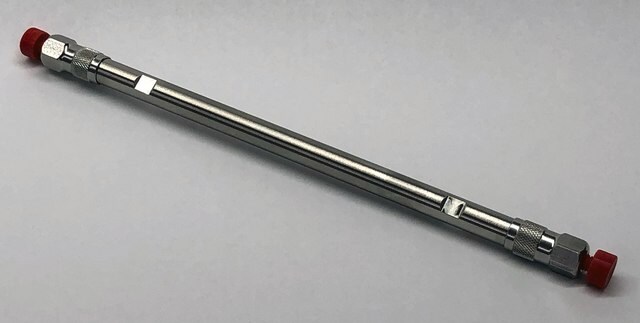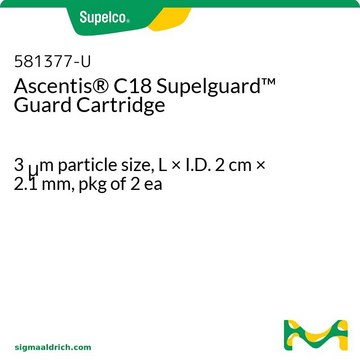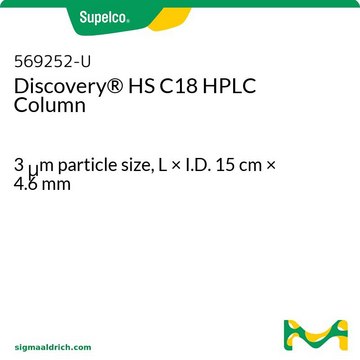581301-U
Ascentis® C18 (3 µm) HPLC Columns
L × I.D. 10 cm × 2.1 mm, HPLC Column
Synonym(s):
Ascentis RP18 HPLC Column
About This Item
Recommended Products
Product Name
Ascentis® C18 HPLC Column, 3 μm particle size, L × I.D. 10 cm × 2.1 mm
material
stainless steel column
Agency
suitable for USP L1 (Similar to Phenomenex Luna C18)
product line
Ascentis®
feature
endcapped
manufacturer/tradename
Ascentis®
packaging
1 ea of
extent of labeling
25% Carbon loading
parameter
≤70 °C temp. range
400 bar pressure (5801 psi)
technique(s)
HPLC: suitable
LC/MS: suitable
L × I.D.
10 cm × 2.1 mm
surface area
450 m2/g
surface coverage
3.7 μmol/m2
impurities
<5 ppm metals
matrix
fully porous particle
silica gel high purity, spherical
matrix active group
C18 (octadecyl) phase
particle size
3 μm
pore size
100 Å
operating pH range
2-8
application(s)
food and beverages
separation technique
reversed phase
Looking for similar products? Visit Product Comparison Guide
Related Categories
General description
Ascentis C18 is an extremely stable and reliable first choice HPLC column that gives symmetric peak shape and excellent retention even for difficult compounds.
Application
- Identification of recombinant human insulin and biosynthetic insulin analogues by multiplexed targeted unlabeled mass spectrometry of proteotypic tryptic peptides.: This study employs the Ascentis® C18 HPLC column for the separation of proteotypic tryptic peptides, allowing the identification of human insulin and biosynthetic insulin analogues through multiplexed targeted unlabeled mass spectrometry. The method demonstrated high specificity and sensitivity, enhancing the accuracy of insulin analysis in pharmaceutical research (Qasem et al., 2019).
- Development and validation of a novel stability-indicating HPLC method for the simultaneous assay of betamethasone-17-valerate, fusidic acid, potassium sorbate, methylparaben, and propylparaben in a topical cream preparation.: Utilizing the Ascentis® C18 HPLC column, this research presents a novel stability-indicating method for the simultaneous assay of multiple compounds in a topical cream. The validated method offers robust stability assessment, critical for ensuring the quality and efficacy of pharmaceutical formulations (Byrne et al., 2014).
- HPLC-DAD and HPLC-ESI-MS/MS methods for metabolite profiling of propolis extracts.: This paper describes the use of the Ascentis® C18 HPLC column in HPLC-DAD and HPLC-ESI-MS/MS methods to profile metabolites in propolis extracts. The column′s performance in separating complex mixtures highlights its utility in natural product research and quality control (Pellati et al., 2011).
- Practical comparison of 2.7 microm fused-core silica particles and porous sub-2 microm particles for fast separations in pharmaceutical process development.: This study compares the performance of the Ascentis® C18 HPLC column with other chromatographic columns for fast separations in pharmaceutical process development. The Ascentis® column provided superior separation efficiency and speed, making it advantageous for high-throughput pharmaceutical analysis (Abrahim et al., 2010).
Features and Benefits
- Excellent retention
- Symmetric peak shape
- High reproducibility
- Complete LC-MS compatibility
Legal Information
Application
guard cartridge
Storage Class Code
11 - Combustible Solids
WGK
WGK 3
Flash Point(F)
Not applicable
Flash Point(C)
Not applicable
Choose from one of the most recent versions:
Already Own This Product?
Find documentation for the products that you have recently purchased in the Document Library.
Chromatograms
application for SPE, application for LC-MSOur team of scientists has experience in all areas of research including Life Science, Material Science, Chemical Synthesis, Chromatography, Analytical and many others.
Contact Technical Service







